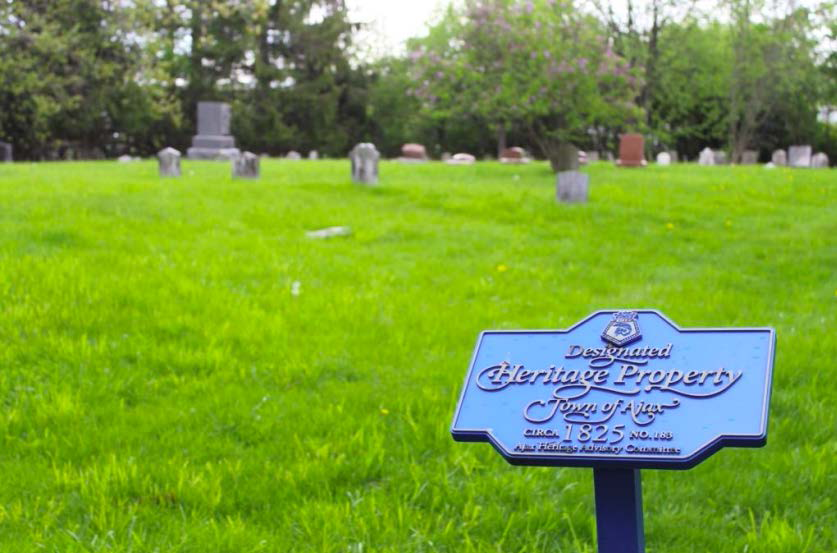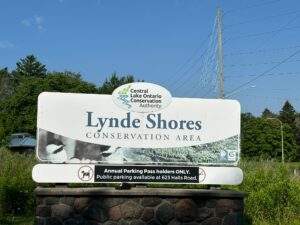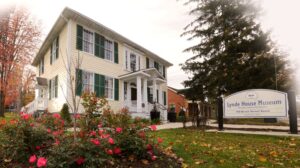War of 1812 Veteran Graveside Project
Biographical Information for Jabez Lynde
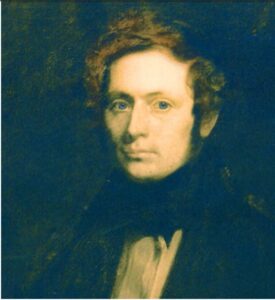 Jabez Lynde was born in Brookfield, Massachusetts in 1773. In 1796, he married Clarissa Woodruff (1774-1830) in Winchester, Connecticut. In response to a posting by the Lieutenant Governor of Upper Canada offering free land for new settlers, Jabez came to Upper Canada with his father-in-law Hawkins Woodruff in 1800. Woodruff secured land in Pickering and Jabez purchased Lot 31, Conc 2 in Whitby for two dollars an acre. They built a log cabin on the Woodruff land to satisfy settlement duties and then returned to the United States to reunite with their families. In 1803, both men returned to Upper Canada with their families. The Lyndes lived with the Woodruff family until 1804 when they completed construction of a log home on their land.[1] They were among the first settlers in Whitby Township[2] and raised eight children[3] while farming the land, hunting, and according to folklore, catching salmon with a pitchfork from the creek on their property that today bears their name.
Jabez Lynde was born in Brookfield, Massachusetts in 1773. In 1796, he married Clarissa Woodruff (1774-1830) in Winchester, Connecticut. In response to a posting by the Lieutenant Governor of Upper Canada offering free land for new settlers, Jabez came to Upper Canada with his father-in-law Hawkins Woodruff in 1800. Woodruff secured land in Pickering and Jabez purchased Lot 31, Conc 2 in Whitby for two dollars an acre. They built a log cabin on the Woodruff land to satisfy settlement duties and then returned to the United States to reunite with their families. In 1803, both men returned to Upper Canada with their families. The Lyndes lived with the Woodruff family until 1804 when they completed construction of a log home on their land.[1] They were among the first settlers in Whitby Township[2] and raised eight children[3] while farming the land, hunting, and according to folklore, catching salmon with a pitchfork from the creek on their property that today bears their name.
Jabez immediately became a contributing member of his new community and by April 1806 had assumed the role of path master in the Townships of Pickering and Whitby. His roles in serving his community would escalate over time, with him being appointed as Town Clerk for the Townships of Pickering and Whitby in 1814 and then serving as a Constable for the Township of Whitby in 1822.[4]
On 31 July 1810, Jabez gave up his American birthright and swore allegiance to King George.[5]
His log home, which was located along the well traveled Kingston Road, was used as an inn on the route between York and Kingston and received a tavern license in 1811. Due to its strategic location, it became a common stop for military personnel. In February 1812, Major General Isaac Brock and Colonel Drummon, Brock’s aide-de-camp, stopped at the Lynde home for a meal and for horses. In spring of the same year, the inn and tavern became a frequent stop for Lieutenant Eli Playter, who was responsible for conscripting eligible males into military service.[6] It was through this relationship with Lieutenant Playter that Jabez was conscribed into the 3rd Regiment of the York Militia.
In 1813, Jabez was a Private in a cavalry responsible for running dispatches between York and Kingston. He reported directly to William Allan, Commanding Officer of the 3rd Regiment. By 1814, his unit was no longer part of the 3rd Regiment and he was listed on muster rolls and pay lists for a small company called the “Kingston Road Detachment of the Home District Militia Cavalry for Carrying Dispatches.” The cavalry reported to Lieutenant Thomas Taylor, who also served as Post Major at Fort York. Jabez is listed as one of four privates stationed in Whitby.[7]
Beyond his personal contributions, Jabez’ home itself played an important role in the War of 1812. The house served as a popular stop for General Isaac Brock and other members of the militia and served as an inn, medical facility, supply depot and source of fresh horses.[8] In April 1813, after the capture of the Town of York by the Americans, Brigadier General Sheaffe and his army retreated to Kingston, making a stop at the Lynde House for supplies. Two surgeons, Dr. Lee and Dr. Powell, who were working frantically to provide medical aid, asked Jabez to save his 18 gallons of spirits (largely rum) to be used as painkiller for wounded soldiers. However, shortly after the doctors left, a party of 8th Regiment soldiers arrived and seized the spirits while ransacking the home.
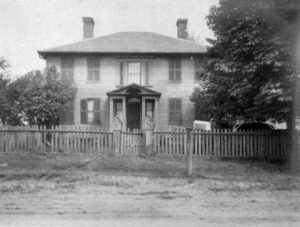 Jabez would soon after make a war loss claim[9] to recover the value of the goods taken by retreating soldiers. Whether inspired by this raid or entirely by other reasons, Jabez had a handsome new Georgian home constructed on his property by 1814. The old log home was retained to function as the tavern and Jabez returned to his dispatch role in the military. Jabez’ oldest son, Sylvester, claimed to have carried dispatches from Lynde’s tavern to the tavern in Oshawa, but his name does not appear on the muster rolls. However, his first Canadian-born son, Hawkins, who was only 12 years of age at the time, is officially listed as serving in January of 1815.[10]
Jabez would soon after make a war loss claim[9] to recover the value of the goods taken by retreating soldiers. Whether inspired by this raid or entirely by other reasons, Jabez had a handsome new Georgian home constructed on his property by 1814. The old log home was retained to function as the tavern and Jabez returned to his dispatch role in the military. Jabez’ oldest son, Sylvester, claimed to have carried dispatches from Lynde’s tavern to the tavern in Oshawa, but his name does not appear on the muster rolls. However, his first Canadian-born son, Hawkins, who was only 12 years of age at the time, is officially listed as serving in January of 1815.[10]
Following the war, Jabez’ wife Clarissa joined the Society of Friends in 1817 and began attending meetings at the Pickering meeting house. Jabez described himself as a Universalist throughout his life but was likely influenced by his wife’s faith in his decision to cease tavern operations in 1818. After the great Quaker separation in 1828, Clarissa joined the Hicksite following and was disowned at the Pickering Quaker meeting of November 13, 1828.[11] She became a devoted member of the Hicksites and attended meetings on lands donated by the Brown family on the north side of Kingston Road in Pickering. Clarissa died in 1830 at the age of 56 and is buried in the Hicksite-Brown Cemetery, at the rear of the property where the meeting house once stood.
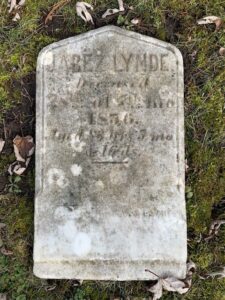 Jabez Lynde died in his Whitby home on 27 July 1856 in his 85th year. He is buried in the Hicksite-Brown Cemetery with his wife, Clarissa, and their children, Elmina and Warner.
Jabez Lynde died in his Whitby home on 27 July 1856 in his 85th year. He is buried in the Hicksite-Brown Cemetery with his wife, Clarissa, and their children, Elmina and Warner.
The Lynde family name is a prominent and celebrated one in Durham Region and appears today in the naming of Lynde Creek, Lynde Shores Conservation Area, Lynde Creek Village and West Lynde Public School. Jabez and Clarrissa’s daughter, Elmina, was the last of the Lynde family to live in their 1814 family home, residing there until her death in 1893.[12] The house is currently the oldest in Durham Region and has been moved several times, residing since 2013 at 900 Brock Street South in Whitby. The Whitby Historical Society currently operates the home as a museum, educating the public on the Lynde family’s importance to the history of Whitby and Durham Region.[13] In 1998, Sybil C. Lynde, a descendent of Jabez Lynde, published To a House in Whitby: The Lynde Family Story 1600-1900 to capture and preserve the family’s story.
 This submission is made on behalf of the Ajax Heritage Advisory Committee. As discussed in a previous communication, an assessment has been completed and a budget request submitted for the restoration and rehabilitation of the Hicksite-Brown Cemetery in 2025. It is the committee’s intent to have the plaque installed as part of the cemetery restoration and specifically the restoration to a vertical position of Jabez Lynde’s grave marker. A ceremony would occur following this work.
This submission is made on behalf of the Ajax Heritage Advisory Committee. As discussed in a previous communication, an assessment has been completed and a budget request submitted for the restoration and rehabilitation of the Hicksite-Brown Cemetery in 2025. It is the committee’s intent to have the plaque installed as part of the cemetery restoration and specifically the restoration to a vertical position of Jabez Lynde’s grave marker. A ceremony would occur following this work.
[1] To a House in Whitby. The Lynde Family Story 1600-1900 by Sybil C. Lynde (pg 85-91)
[2] 200.pdf (pickering.ca)
[3] Jabez Lynde (1773-1856) | WikiTree FREE Family Tree
[4] To a House in Whitby. The Lynde Family Story 1600-1900 by Sybil C. Lynde (pg 95)
[5] To a House in Whitby. The Lynde Family Story 1600-1900 by Sybil C. Lynde (pg 96)
[6] To a House in Whitby. The Lynde Family Story 1600-1900 by Sybil C. Lynde (pg 100-103)
[7] Jabez Lynde (1773-1856) | WikiTree FREE Family Tree
[8] Part 1: The War of 1812 with Historical Author Tom Taylor & Lynde House Museum Curator, Monica Effenberger – Gwen Tuinman
[9] Collections Canada, The War of 1812: Board of Claims for Losses, 1813-1848, Microfilm t-1143, Pages 1165-1167
[10] To a House in Whitby. The Lynde Family Story 1600-1900 by Sybil C. Lynde (pg 108)
[11] To a House in Whitby. The Lynde Family Story 1600-1900 by Sybil C. Lynde (pg 125, 139)
[12] To a House in Whitby. The Lynde Family Story 1600-1900 by Sybil C. Lynde (pg 134)
[13] HOME • Lynde House Museum
Veteran Summary
Jabez LyndePrivate, 3rd Regiment York Militia
Place of Birth
Brookfield, , Massachusetts, USA
Place of Death
Whitby, Ontario, CAN
Died on:
Reason: Old Age He was 85 years old
Location of Grave
Hicksite - Brown Quaker Cemetery (Designation By-law 12 Feb 2007), 310 Kingston Road East
Ajax, Durham Regional Municipality,, ON, CAN
Latitude: 43.86551N Longitude: -79.01088

